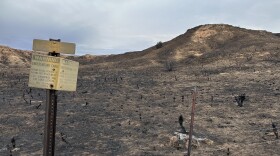Some health care providers in the Midwest say they are seeing more respiratory illnesses in the past few days possibly related to the wildfires in Canada. Air quality across the Midwest dipped to concerning levels beginning Tuesday.
In Iowa, providers at MercyOne clinics around Des Moines say more patients than usual are showing up with symptoms in line with air pollution, including exacerbated asthma and COPD.
In Madison, Wisconsin, a spokesperson for SSM Health St. Mary’s Hospital says its pulmonologist has seen an increase in patients with COPD and long-term lung conditions experiencing breathing irritations.
A representative for Nebraska Medicine clinics says providers have not seen a significant increase, yet.
As for when the air should clear, the EPA says it depends on how long the wildfires last.
EPA Physical Scientist Lance Avey said air quality this time of year already is lower because of ozone issues in Iowa, Kansas, Missouri and Nebraska – Region 7 that Avey oversees.
“We’re definitely seeing high air quality impacts in the Midwest and in Region 7 that are potentially being impacted by the Canadian wildfire smoke,” Avey said. “But its also mixed in there with our typical summertime conditions.”
That means people who are sensitive to changes in air quality may experience health effects.
An estimated 136 fires rage near Quebec, along with more than 400 other wildfires across Canada, according to the Society for the Protection of Forest Against Fire, a nonprofit organization in Quebec that monitors wildfires.
Smoke from the Canada fires has hammered air quality in places like New York and caused hazy skies and reduced visibility.
“There are numerous large fires lots of uncontrolled fires up there — as long as they’re still burning there’s going to be the potential to impact air quality in the U.S. and the Midwest,” Avey said. “It's the weather pattern that can change from day-to-day, week-to-week that are going to drive the impact to areas of the U.S.”
Avey said while the weather pattern currently is moving the lion’s share of the wildfire smoke and particulate matter to the northeast portion of the U.S., a change in the wind could put the Midwest in danger.
“That has the ability to shift and we may see greater impacts in the Midwest,” Avey said.
Particulate problems
Air pollution from wildfires is a growing health risk, according to Angela Tin, national senior director of the American Lung Association.
“The wildfire is different from a prescribed burn,” Tin said. “The temperature is uncontrolled, the fuel is uncontrolled because different types of materials are burning. So the smoke is going up in the air and depending on the wind and terrain it comes down in unpredictable areas.”
Tin said she’s concerned that the fires are spreading particulate matter across long distances. She said that’s making things worse for the Midwest, where particle pollution is already an issue.
“The fine particulates find their way deep into the body and deep into the lungs and into the bloodstream,” Tin said. “That’s why it's a respiratory and cardiovascular concern.”
She added there are short-term and long-term effects to exposure to the particles, including chronic bronchitis, reduced lung function, lung cancer, and in some cases, heart disease.
With the wildfires in mind, Tin said people should try to limit their time outside when air quality is poor and stay up to date on alerts with the EPA’s AirNow air quality tracker. She said people who have respiratory issues can also use air purifiers while in their homes, as heavy wildfire smoke can often make its way inside homes.
Kristofor Husted contributed to this report.
The Midwest Newsroom is an in-depth and investigative journalism collaboration including KCUR, St. Louis Public Radio, Iowa Public Radio, Nebraska Public Media and NPR.








